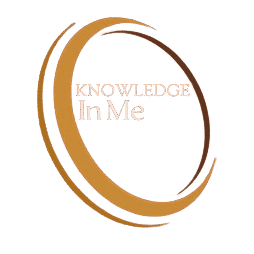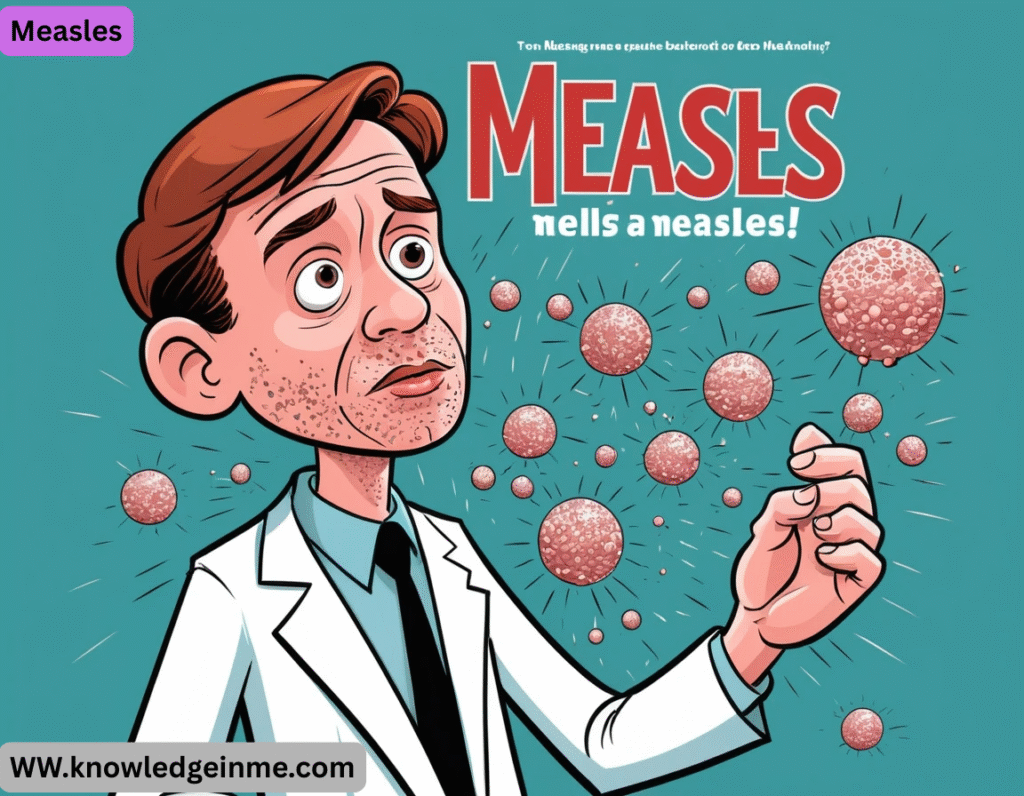Measles It primarily affects children but can infect unvaccinated individuals of any age.
Key Facts
- Transmission: Spread via respiratory droplets (coughing, sneezing) or direct contact with infected secretions.
- Incubation Period: 10–14 days before symptoms appear.
- Complications: Can be severe, especially in malnourished or immunocompromised individuals.
Symptoms
Symptoms typically occur in two stages:
Prodromal Stage Before Rash
High fever (up to 104°F/40°C)
- “3 Cs”:
- Cough
- Coryza (runny nose)
- Conjunctivitis (red, watery eyes)
- KOPLIK’s spots (tiny white spots on the inner cheeks) – a classic sign.
Rash Stage
Rash lasts 5–7 days before fading.
Complications
- Measles can lead to serious health issues, including:
- Pneumonia (most common cause of measles-related deaths)
- Encephalitis (brain inflammation, can cause permanent damage)
Diagnosis
- Clinical diagnosis based on symptoms and exposure history.
- Lab tests (if needed):
- IgM antibody test (acute infection)
- PCR (viral detection in throat/nose swabs)
Treatment
- No specific antiviral treatment exists.
- Supportive care includes:
Hydration
- Fever control (acetaminophen/ibuprofen)
- Vitamin A supplementation (reduces complications in children)
- Antibiotics if secondary bacterial infections (e.g., pneumonia, ear infections) occur.
Prevention
- Vaccination is the best protection (MMR vaccine: Measles, Mumps, Rubella).
- Two doses (first at 12–15 months, second at 4–6 years).
- Effectiveness: ~97% after two doses.
- Isolation of infected individuals to prevent spread.
Causative Agent
- Virus: Measles virus (MeV), genus Morbillivirus, family Paramy xoviridae.
- Genome: Single-stranded, negative-sense RNA.
- Stability: Dies quickly outside the host (survives <2 hours in air/on surfaces).
Transmission Dynamics
- Highly contagious: R₀ (Basic Reproduction Number) = 12–18 (meaning one infected person can spread it to 12–18 unvaccinated people).
Spread via:
- Airborne respiratory droplets (sneezing/coughing).
- Direct contact with nasal/throat secretions.
- High-risk settings: Schools, refugee camps, healthcare facilities.
Pathophysiology How the Virus Affects the Body
- Entry: Infects respiratory tract → spreads to local lymph nodes.
- Primary viremia: Virus enters bloodstream → infects immune cells.
- Secondary viremia: Spreads to skin, lungs, liver, and brain.
- Immune suppression: Destroys immune memory cells, increasing vulnerability to other infections.
Clinical Features in Detail
- Prodromal Phase (2–4 days before rash)
- Fever (often >40°C / 104°F).
- “3 Cs”:
- Cough (dry, hacking).
- Coryza (severe runny nose).
- Conjunctivitis (red eyes, photophobia).
- Koplik’s spots (pathognomonic sign):
- Tiny white lesions on buccal mucosa (appear 1–2 days before rash).
- Exanthem Phase (Rash Stage)
Rash progression:
- Starts at hairline/face → spreads downward (trunk, limbs).
- Maculopapular (flat red spots merging into patches).
- Fades in 5–7 days (may leave brownish discoloration/peeling).
- Fever persists until rash fully develops.
Atypical Presentations
- Modified measles (milder, in partially immune individuals).
- Hemorrhagic measles (rare, severe bleeding under skin).
Diagnosis Lab & Clinical Confirmation
- Clinical Diagnosis (WHO Criteria)
- Fever + generalized rash + cough/coryza/conjunctivitis.
- Koplik’s spots confirm diagnosis but are often missed.
Laboratory Tests
- IgM ELISA (detects antibodies 3+ days after rash onset).
- RT-PCR (nasopharyngeal/throat swab, best in early infection).
- Viral culture (rarely used, research settings).
Treatment & Management
Supportive Care
- Hydration (oral rehydration or IV if severe).
- Fever control (acetaminophen/ibuprofen; avoid aspirin in kids).
- Vitamin A supplementation (reduces mortality in children):
- Dosing: 50,000–200,000 IU (depending on age, given for 2 days).
Antibiotics
- Only for secondary bacterial infections (e.g., otitis media, pneumonia).
Hospitalization Needed If:
- Severe respiratory distress, encephalitis, or dehydration.
Prevention Strategies
- Vaccination (MMR or MMRV)
- MMR Vaccine: Live-attenuated (safe, effective).
- Dose 1: 12–15 months (~93% effective).
- Dose 2: 4–6 years (~97% effective).
- Catch-up vaccination: Unvaccinated adults should get 1–2 doses.
- Contraindications: Pregnancy, severe immunodeficiency.
- Post-Exposure Prophylaxis (PEP)
- Vaccine within 72 HRS(may prevent/modify disease).
- Immunoglobulin (Ig) within 6 days (for high-risk groups like infants/pregnant women).
Infection Control
- Isolate cases (4 days before to 4 days after rash).
- Quarantine unvaccinated contacts for 21 days.
Global Epidemiology & Outbreaks
- Pre-vaccine era: ~2.6 million deaths/year (mostly children).
- Current burden: ~136,000 deaths/year (2022, WHO).
Outbreaks in:
- Low-coverage areas (Africa, Southeast Asia).
- Vaccine-hesitant communities (e.g., USA, Europe).
- Elimination status: Some regions (Americas, parts of Europe) have eliminated endemic measles but face imported cases.
Advanced Virology of Measles Virus
Viral Structure:
- Enveloped virus with H (hemagglutinin) and F (fusion) glycoprotein spikes
- H protein binds to host receptors (CD150/SLAM on immune cells, nectin-4 on epithelial cells)
- F protein mediates membrane fusion and cell entry
Replication Cycle:
- Attachment to CD150+ immune cells (dendritic cells, macrophages)
- Fusion and release of viral RNA into cytoplasm
- RNA-dependent RNA polymerase synthesizes mRNA
- Viral assembly at cell membrane
- Budding from infected cells (spread via cell-cell fusion)
Host Immune Response
Innate Immunity:
- TLR7/8 recognize viral RNA → interferon production
- NK cell activation within 2-3 days of infection
Adaptive Immunity:
- CD8+ T-cells cause rash through cytotoxic response
- Neutralizing antibodies target H protein (appear with rash)
- Lifelong immunity after natural infection
Immune Amnesia:
MeV infects memory B/T cells
- Causes 11-73% loss of existing antibodies (lasts 2-3 years)
- Increases mortality from other infections post-measles
Molecular Epidemiology
Genotyping:
- WHO recognizes 24 genotypes (A, B1-3, C1-2, D1-10, etc.)
- B3 and D8 currently circulating globally
- Genotyping helps track transmission chains
Viral Evolution:
- Mutation rate: ~10^-4 substitutions/site/year
- H gene most variable (positive selection pressure)
Advanced Clinical Management
High-Risk Groups:
- HIV+ children: 50% mortality without ART
- Cancer patients: May develop giant cell pneumonia
- Malnourished children: 10x higher fatality rate
- Novel Therapeutics (Experimental):
- ERDRP-0519 (oral polymerase inhibitor)
- Ribavirin (for SSPE, investigational)
- Fusion inhibitor peptides
Outbreak Investigation Protocol
Case Definition:
- Suspected: Fever + rash + cough/coryza/conjunctivitis
- Confirmed: Lab verification OR epidemiologic link
Contact Tracing:
- Identify exposed individuals from 7d before to 21d after rash
- Classify contacts by vaccination status
Laboratory Network:
- WHO Measles and Rubella Laboratory Network (800+ labs)
- Genotyping for outbreak linkage
Vaccine Science
Strain History:
- Original EDMONSTON strain (1954)
- Current vaccine: EDMONSTON -Zagreb or MORATEN strains
Correlates of Protection:
- Neutralizing antibody titer >120 MIU/mL
- ELISA IgG >200 MIU/mL
Vaccine Failure:
- Primary (2-5% of recipients don’t respond)
- Secondary (waning immunity in 1/100,000 after 2 doses)
Historical Impact
- 9th Century: Persian physician Rhazes distinguishes measles from smallpox
- 1846: Panum studies Faroe Islands epidemic, proves lifelong immunity
- 1954: Enders isolates virus (Nobel Prize 1961)
- 1963: First licensed vaccine (inactivated, later withdrawn)
- 2000-2020: Vaccines prevent ~31 million deaths globally
Current Research Frontiers
Transmission Modeling:
- Super-spreaders cause 80% of transmissions
- School-age children drive outbreaks (R0=18 in schools)
Eradication Feasibility:
- Only human reservoir (unlike polio)
- Challenges: Vaccine hesitancy, cold chain requirements
- Next target after polio (potential eradication by 2040)
Economic Burden
US Outbreak Costs:
- $4.6 million per outbreak (median)
- $20,000 per case (public health response)
Global Costs:
- $1.5 billion/year in treatment
- $2.1 billion/year in productivity losses
Special Populations
Healthcare Workers:
- 5-10% lack immunity (require serologic testing)
- Highest exposure risk in ER and pediatric units
Adults Born 1963-1989:
- May have received ineffective early vaccines
- Need serologic testing/revaccination
Diagnostic Challenges
Atypical Presentations:
- Vaccine-modified measles (milder, no KOPLIK spots)
- Immunocompromised: No rash (“black measles” – hemorrhagic)
PCR Pitfalls:
- False negatives after 5 days of rash
- Must target N gene (H gene mutations cause false negatives)






